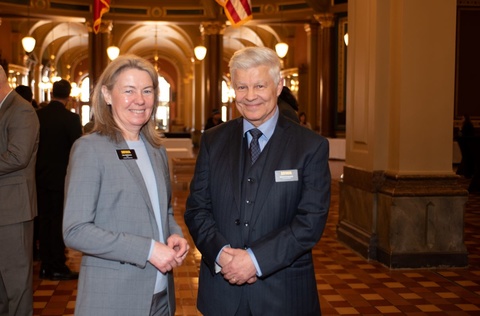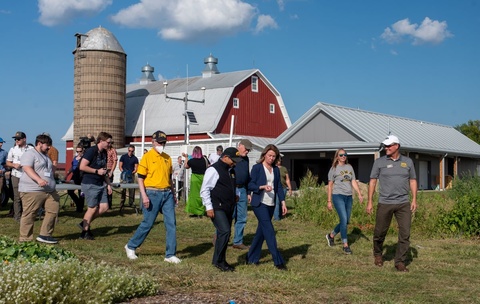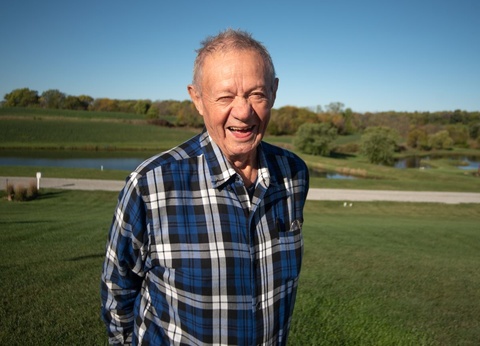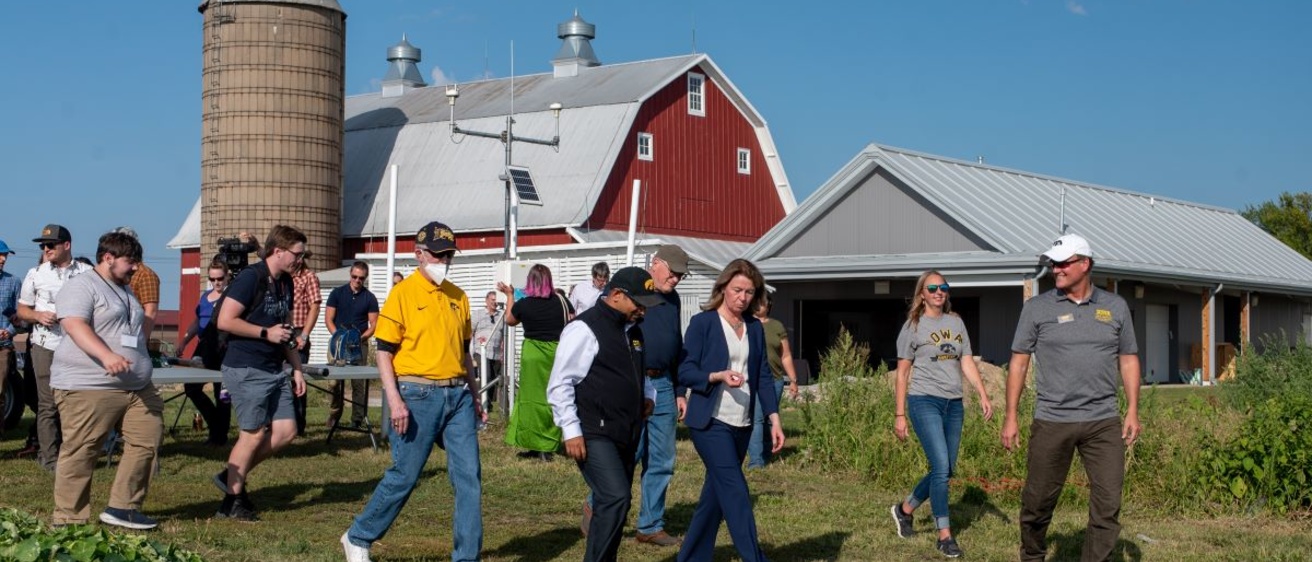Welcome, Dean McKenna!

Dean Ann McKenna joined the College of Engineering in August 2023. She previously served as the vice dean of strategic advancement at the Ira A. Fulton Schools of Engineering at Arizona State University and was a professor of engineering in the Polytechnic School. In February 2024, McKenna joined the Iowa Flood Center and Iowa Geological Survey for their annual Legislative Breakfast Reception at the Iowa State Capitol in Des Moines to meet legislators and partners and highlight the services and value the organizations provide for the state of Iowa.
Alumni connections

More than a school or workplace, IIHR is a family for life. Being a part of the institute means forever having a place to call home. IIHR’s robust alumni network provides opportunities to connect and inspires collaborations across the globe.
IIHR alum Bo Chen visited Iowa for a week-long visit with five colleagues from Beijing Normal University in China. The group came to exchange research ideas and best practices for managing water resources, including advancing flood prediction and mitigation, reducing soil erosion, improving water quality, and enhancing community outreach and engagement. The group toured IIHR research facilities and field sites to meet with policymakers, landowners, and county and city staff. The team also spent time with colleagues at Iowa State University, learning about conservation initiatives through the Iowa Nutrient Research Center.
Cultivating partnerships

The Johnson County Historic Poor Farm (JCHPF) serves as a living laboratory for University of Iowa researchers and students to advance their research and succeed as the next engineers and biologists of the world. In the past 10 years, the farm’s landscape has witnessed significant conservation enhancements, ranging from innovative crop management practices that focus on soil health, pollinator habitat, and cover crops, to the installation of wetlands aimed at slowing sediment and improving water quality. It’s an environmentalist’s playground.
Since 2019, IIHR—Hydroscience and Engineering, Iowa Geological Survey, and Iowa Flood Center researchers and students have worked on watershed management improvements, groundwater monitoring, real-time water quality measurements, and soil microbiology research. The exploration and discovery cultivated on the farm between local community organizations and the University of Iowa is a unique partnership for advancing science and the understanding of how to effectively mitigate environmental risks. The JCHPF served as a significant location for a $1 million program funded by the Environmental Protection Agency’s Gulf of Mexico Division led by Craig Just, IIHR associate faculty research engineer. Just, who is also a professor of civil and environmental engineering, is studying innovative nutrient and sediment reduction practices that could be scaled up across Iowa.
As implied by its name, the history of the JCHPF is complicated. Founded in 1855, it was one of many county-run poor farms operated throughout the country following the 19th-century social reform movement. The farms were run by local governments and set up to permanently house individuals with difficult life experiences. In exchange, the residents were required to work on the farm. Reckoning with its past, today the farm serves as a beacon for providing equitable opportunities to connect people to the land and come together as a community.
The collaborative success of the JCHPF project is attributed to the contributions and support from various agencies, including Johnson County, Iowa Valley Resource Conservation and Development, Impact7G, the University of Iowa, IIHR—Hydroscience and Engineering, Iowa Geological Survey, the Iowa College of Engineering, and the U.S. Department of Agriculture Natural Resources Conservation Service. This partnership exemplifies the synergy between academia, government, and private entities in advancing sustainable research and conservation goals.
In memory: Stan Stutzman

Stan Stutzman was the 13th of 14 children. He learned the value of hard work at an early age by working on a neighbor’s farm making hay, milking, and gathering eggs, earning a dollar a day. He graduated eighth grade from a single-room country schoolhouse near Kalona, Iowa, and began driving a truck and working at a local feed mill. With help from his Amish neighbors, he learned to weld and got into maintenance work.
What started as a side job helping mow and take care of former IIHR director Hunter Rouse’s yard while Rouse was on sabbatical turned into a 25-year career working at IIHR. Stutzman primarily did pipe welding for river models, dropshaft models, and fish passage projects. He joined IIHR’s shop team in February 1960 working with shop manager Dale Harris. And it wasn’t all welding — he worked with the first computer used to gather data from a meandering bends river model, helped take river measurements alongside shop supervisor Jim Goss for Tatsuaki Nakato, and built and installed flumes for clients all around the country, including Penn State University; Lafayette, Louisiana; Milwaukee, Wisconsin; University of Wisconsin-Madison; and Howard University in Washington, D.C. He also supported Lou Landweber’s ship hydrodynamics research by helping to build the wooden ship models. He later worked with Larry Weber on Columbia River fish passage projects.
Always willing to help wherever needed, he is remembered at IIHR for his enthusiasm and catchphrase, “Oh, wow! That’s amazing!” His warm personality, kindness, and incredible skills helped to expand IIHR’s research portfolio. The standard and legacy of excellence set by Stutzman and his colleagues, both as people and as professionals, remain the cornerstone of IIHR research initiatives today, upheld by our current team of dedicated shop staff. Stutzman passed away on January 24, 2024, at the age of 87.
Leave no trace

Iowa Geological Survey (IGS) hydrogeologist Joe Honings (far right) had the rare opportunity to join colleagues on an expedition in the pristine Coldwater Cave in northeast Iowa. After descending 100 feet down a ladder to reach the cave system below, the team was immersed in the pitch-black, underground world.
Honings, a recent addition to the IGS team who holds a PhD in geology from Louisiana State University, joined the expedition to better understand the cave and the unique research opportunities it provides. The primitive cave system spans 17 miles underground. Unlike many caves in the region and beyond, it has been protected by the Iowa Grotto, which limits traffic and instills in researchers an ethical duty to “leave no trace.” Many cave systems are open to the public, and with the cumulative effects of regular visitors, the ecology and natural formations are changed permanently. Studying the pristine cave in comparison to others in the region can help to inform details about soil age and movement, water flow, and bank erosion rates that can be used to better understand what is happening in similar environments.
Though Coldwater Cave is dark and quiet, it teems with life. A river runs through the system, averaging a balmy 30 degrees Fahrenheit in winter and ranging from ankle to chest deep. Visitors must traverse the cave carefully to avoid accidental injury. The sides of the cave showcase incredible rock formations formed by the steadily flowing water over thousands of years.
Having completed his undergraduate degree in environmental studies from the University of Iowa, Honings is glad to be back and working with the IGS at IIHR. “There’s a great variety of projects. I’m never working on the same thing. It’s a great deal of collaboration with my colleagues, the engineering side of things, and other universities — we are pushing and discovering for science.”
Overheard
“You are very lovable.” – Keith Saunders, director of state relations at the University of Iowa, speaking about the Iowa Flood Center’s statewide success and impact
“We try not to be smelly, but sometimes that happens.” – Craig Just, IIHR associate faculty research engineer, during a presentation on the Iowa Wastewater and Waste to Energy Research Program
“Iowa City is like home.” Bo Chen, IIHR alumnus, during a weeklong visit to Iowa with colleagues from Beijing Normal University
“Always keep the lab broke, and no one will ask any questions.” – Larry Weber, IIHR director, sharing advice from former IIHR Director Jack Kennedy
